- Ram Janmabhoomi
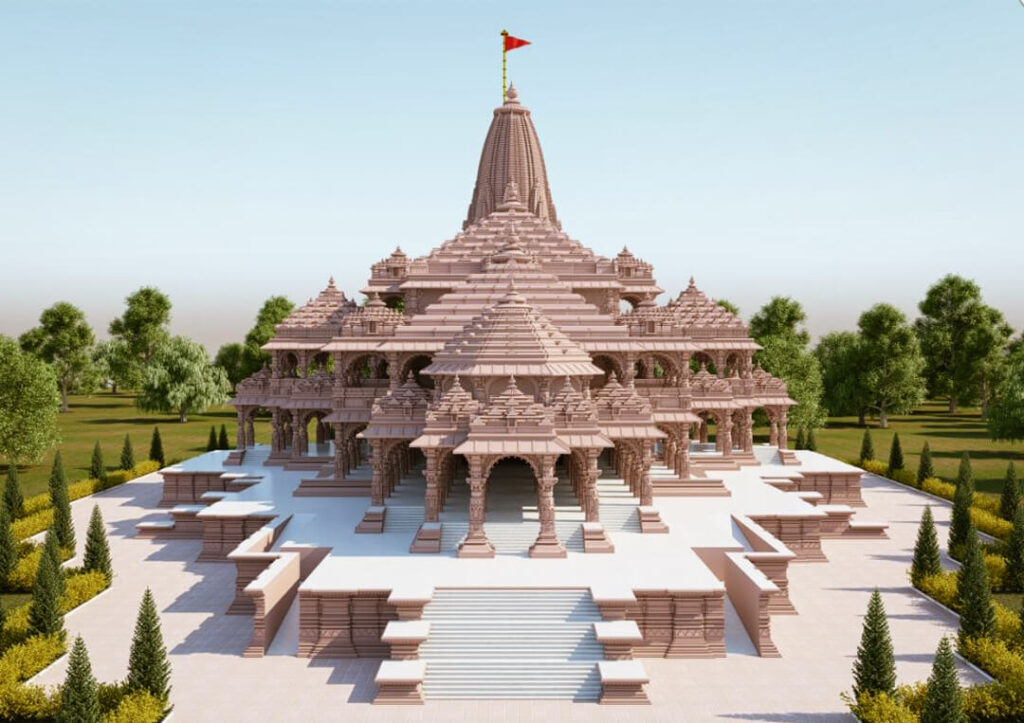
The entire fame & places to visit in Ayodhya city is linked to Ram Janmabhoomi. The Ram Janmabhoomi site holds an emotional place in the hearts of millions of devotees who consider it a pilgrimage destination. According to Hindu mythological belief, the birthplace of Lord Shri Ram is famous by the name of Ram Janmabhoomi. This is the land where Lord Shri Ram was born and played in childhood and spent his entire life here and finally went to Vaikuntha Dham (Heaven). It’s been an integral part of Indian cultural heritage for thousands of years. Here you can see the newly constructed grand temple which is a wonderful example of the incredible architecture of new India.
Location
Ram Janmabhoomi site is situated near the bank of the Saryu River, which is just 1 kilometer away from Ayodhya Dham junction.
How To Reach
Ayodhya Dham Junction is well connected with major cities of India & this site is just 1 kilometer away from the railway junction. So, You can hire a rikshaw or cab easily. Some pilgrims also prefer to go on foot. The newly developed Ayodhya airport is approximately 13 kilometers from the Ram Janmabhoomi site. So you can use the same according to your comfort.
- Hanumangarhi
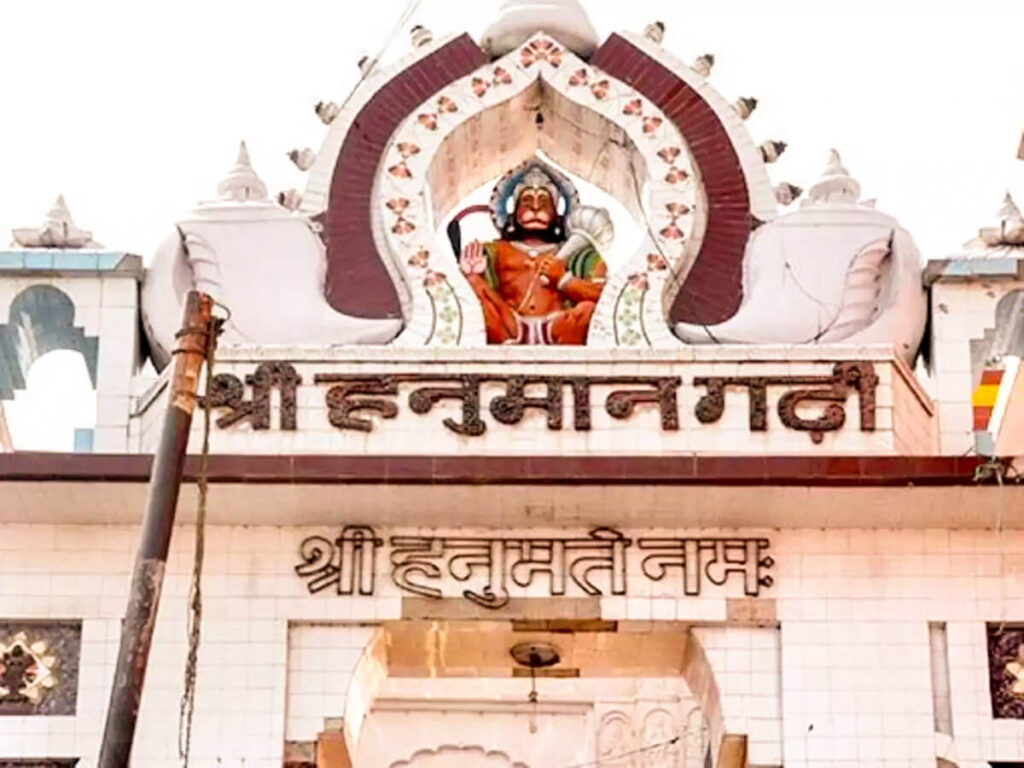
The entire Hanumangarhi Complex is dedicated to Lord Shri Hanuman, the most beloved devotee of Lord Rama. It’s one of the most exploring places to visit in Ayodhya. This complex is looks like a magnificent fort, with four corners adorned by circular bastions. The stunning structure reflects the protection that Hanuman embodies. You have to climb 76 steps to reach near the main prayer place. It’s lined with shops selling religious things. Each step gives you an unique experience about the impact of Lord Hanuman. The main temple holds a statue of Hanumanji with radiating divine energy. Devotees offer prayers and seek blessings for strength, courage, and devotion. The complex encompasses other shrines, including a dedicated space for Maa Anjani, Hanuman’s mother and a cave temple associated with Hanuman’s residence.
Location
This place is Situated in the heart of Ayodhya, just 1 kilometer from Ram Janmabhoomi.
How To Reach
You can follow the same procedure as reaching Ram Janmabhoomi because it’s also situated in almost nearby.
- Kanak Bhawan
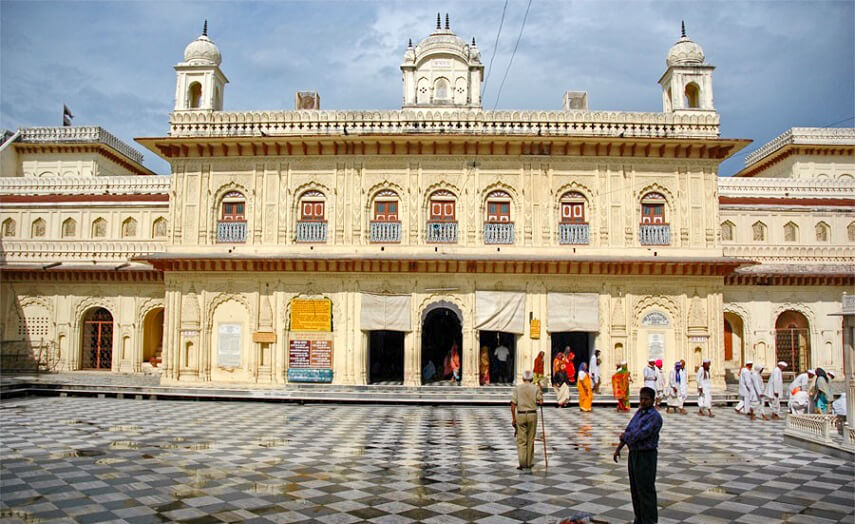
Kanak Bhawan, a gem in Ayodhya’s Crown is a wonderful example of North and South Indian architecture. This religious site is dedicated to Goddess Sita, Wife of Lord Ram. With a rich historical background, It’s believed to have been developed by Queen Holkar of Indore in the early 20th century. The temple was constructed to replace an older temple that was in a state of disrepair. This complex can be found in the top-left portion of the Ram Temple complex and also popularly known as “Sone-ka-Ghar”.
Visiting Kanak Bhawan offers not only an exciting religious experience but also a chance to appreciate the architectural and cultural heritage of Ayodhya city. The temple’s historical importance, artistic beauty and spiritual ecosystem make it a must-visit destination for pilgrims and tourists.
Location
Kanak Bhawan is highly 400 meters northeast of the Ram Janmabhoomi site and approximately 800 meters away from another prominent landmark of Ayodhya, Hanuman Garhi.
How To Reach
This place is situated near of prominent temple in Ayodhya. So you can follow the same procedure as reaching the Ram Janmabhoomi site & others.
- Treta Ke Thakur
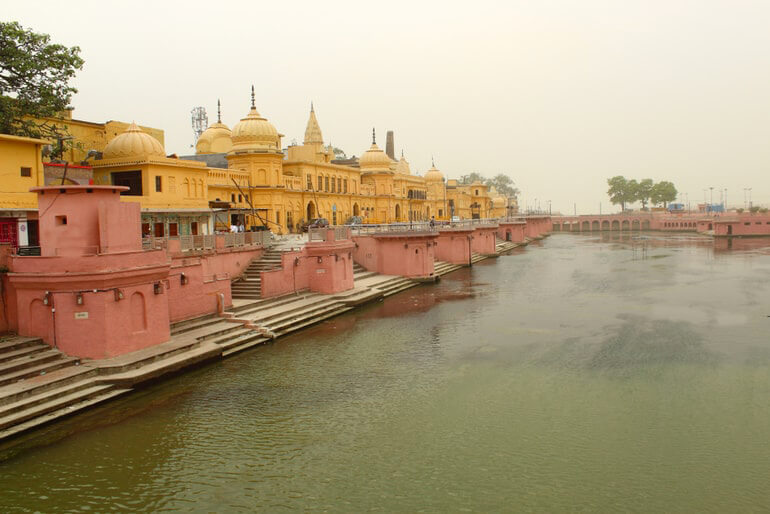
Treta Ke Thakur” tells about the three divine power, Lord Rama, his wife Sita, and his beloved devotee Hanuman. The term specifically shows the most powerful & spiritual figures in the Treta Yuga, the second of the four yugas or ages in Hindu cosmology. You can easily find here the statues of Lord Ram’s brothers, friends & relatives like Bharat, Laxman, Shatrughn, Sugreev & others.
According to mythological beliefs, the Ashwamedha Yagna was done by Lord Ram just here on the earth, which is now dedicated to this monument. Maratha queen Ahilyabai Holkar gave the temple an additional facelift in the 1700s.
Location
This important place is associated with other popular religious sites in Ayodhya.
How to Reach
This Spiritual site is nearby with other religious sites in Ayodhya city. So you can reach here easily.
- Nageshwarnath Temple
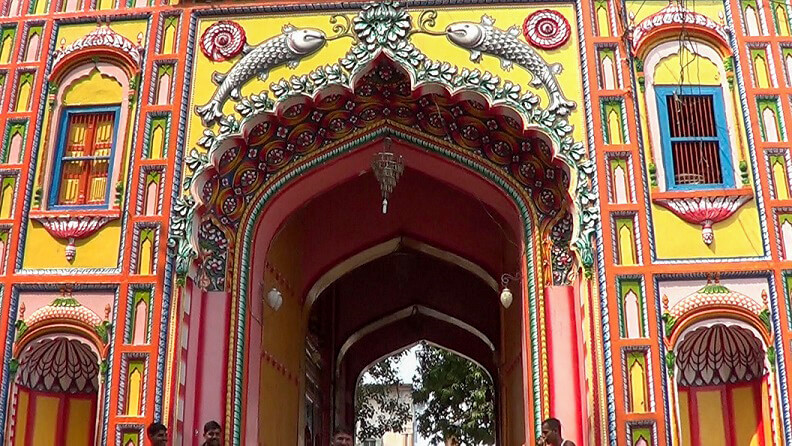
According to spiritual beliefs, Nageshwarnath Temple is considered as one of the highly respectful 12 Jyotirlingas. This temple is basically dedicated to the Hindu god Lord Shiva. It’s believed to have been constructed by Kush, the son of Lord Ram, making it a site with connections to the Treta Yuga and the great epic Ramayana.
This adorable temple shows an Incredible traditional North Indian architecture. But due to ongoing renovations in different time periods, you can feel the architectural impact of parallel times.
Location
You can find The Nageshwarnath Temple, right next to the Theri Bazaar in Ayodhya City.
How To Reach
It’s situated in an accessible location in Ayodhya. SO You can take a rikshaw or cab from Ayodhya Dham railway junction or Airport for this location in Theri bazar, Ayodhya.
Further Read: Bodhgaya – A Complete Travel Guide
- Ramkatha Park
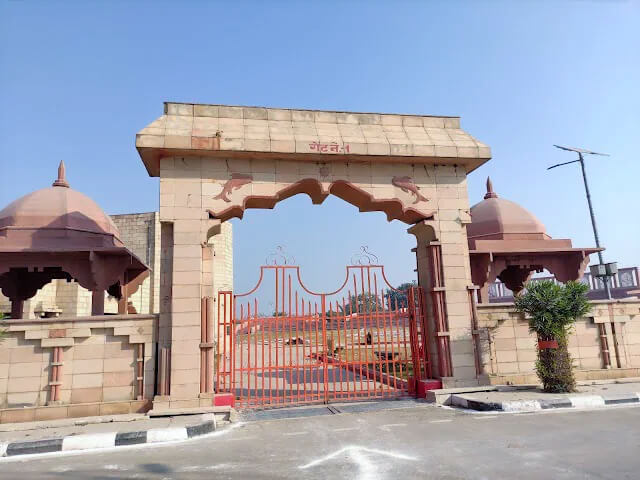
Ramkatha Park is a historical place of Ayodhya which has been witness to countless historical events and situated near the bank of Saryu River. vast green areas, beautiful landscapes, Clean air and gardens with a variety of flowers and trees, this park is enough to leave you spellbound. Here you can relax and enjoy the beautiful nature with closed eyes.
This Park is not just about panoramic views. It’s also a vibrant hub for cultural and religious activities. The park’s open-air theatres regularly host devotional programs, ritual katha and various cultural performances. You must visit this place once to get the pure vibes of Ayodhya City.
Location
Ram Katha Park is around 3 kilometers from Ayodhya Dham Junction.
How to Reach
You can reach here by public & private transport easily from Ayodhya Dham Junction or Ayodhya Airport due to it’s strategic location.
- Ram Ki Paidi (Saryu Ghat)
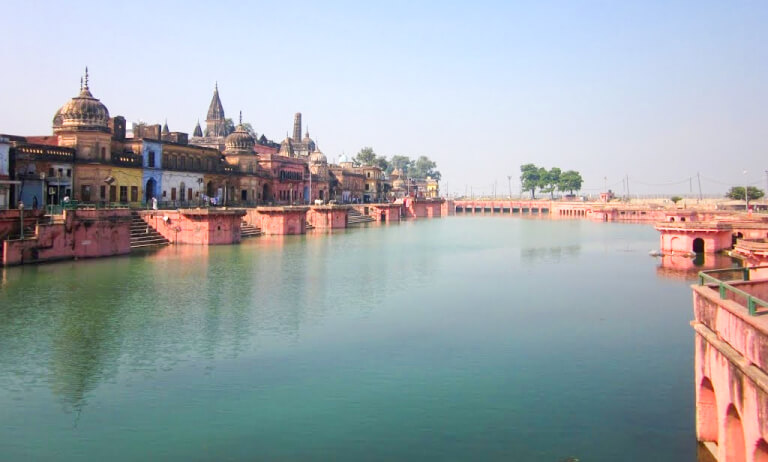
Ram Ki Paidi is a series of ghats located on the banks of the Saryu River in the city of Ayodhya in the state of Uttar Pradesh, India. It is an important Hindu pilgrimage site, where a large number of devotees come every day to take a bath in the sacred Saryu waters. According to spiritual beliefs about Ram Ki Paidi, Lord Rama took a bath at this place during his exile. Later, many temples and other religious places were built at this place.
currently, Ram Ki Paidi is a popular tourist destination. There are many temples, ghats, and other religious places here. The ghats are crowded with devotees, especially during festivals.
Location
This series of ghats is located on the banks of The Saryu River in Ayodhya.
How to Reach
It is easily accessible from all major places of the city. You can come here by bus, cab or taxi.
- Sita ki Rasoi
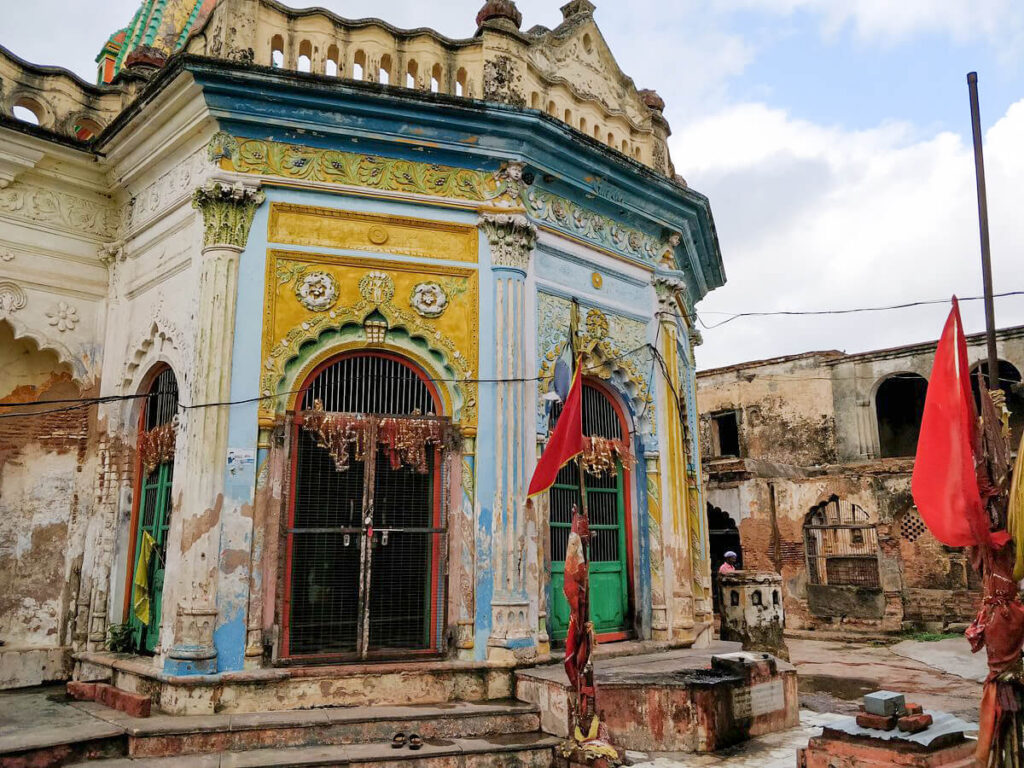
Sita ki Rasoi is situated on the northwest area of the Ram Janmabhoomi, Ayodhya. As per religious beliefs, this historic kitchen was used by the goddess Sita. This prominent location is now transformed in a temple, where some ancient utensils are kept as symbols of that period. It’s located very close to the Ram Janmabhoomi.
Goddess Sita is considered as the Goddess of Food & Prosperity, and also popular with the name Goddess Annapurna. A Free meal is provided to the pilgrims here by this sacred kitchen.
Location
This kitchen is located near of Ram Janmabhoomi site.
How to Reach
It’s an integral part of the Ram Janmabhoomi site, So you can find it easily while visiting in Ayodhya.
- Tulsi Smarak Bhawan & Museum
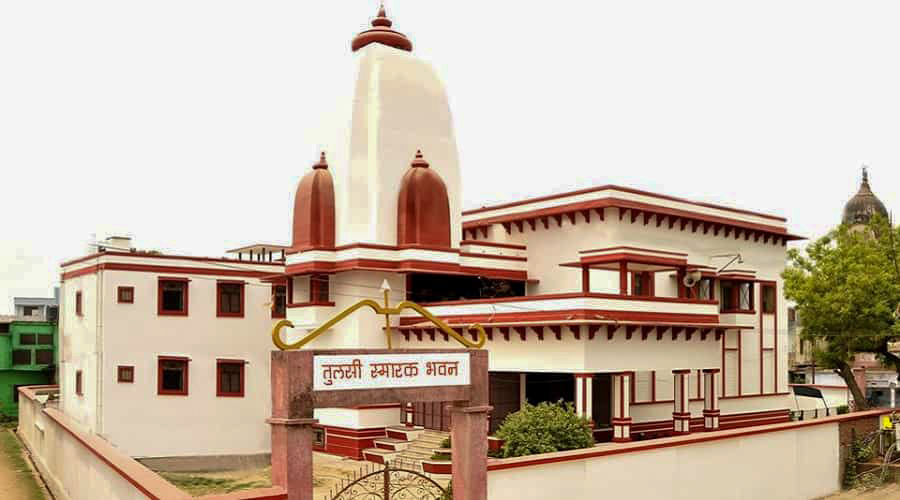
Undoubtedly, if anyone has made the spiritual story of the entire life of Lord Shri Ram i.e. Ramayana popular through his writings, it is Tulsidas. Tulsi Smarak Bhawan & Museum is dedicated to the great creator Tulsidas. Established in 1969, this building is an incredible example of architecture. The complex has a museum, a research center, a library, a cultural center, and a beautiful garden offering educational & devotional experiences for visitors.
You can find here Manuscripts of the epic poem in various languages, paintings depicting scenes from the Ramayana, sculptures of Tulsidas, and many personal belongings of the renowned poet on display.
Location
This beautiful site is located in the Shaheed Marg of Ayodhya & associated with other famous visiting sites.
How to Reach
If you can come here with both public & private transport mediums. This site is located within the main city of Ayodhya. So It’s easily accessible and a must-visit for everyone exploring the city’s rich spiritual heritage.
- Bahu Begum Ka Maqbara (Tomb Of Bahu Begum)
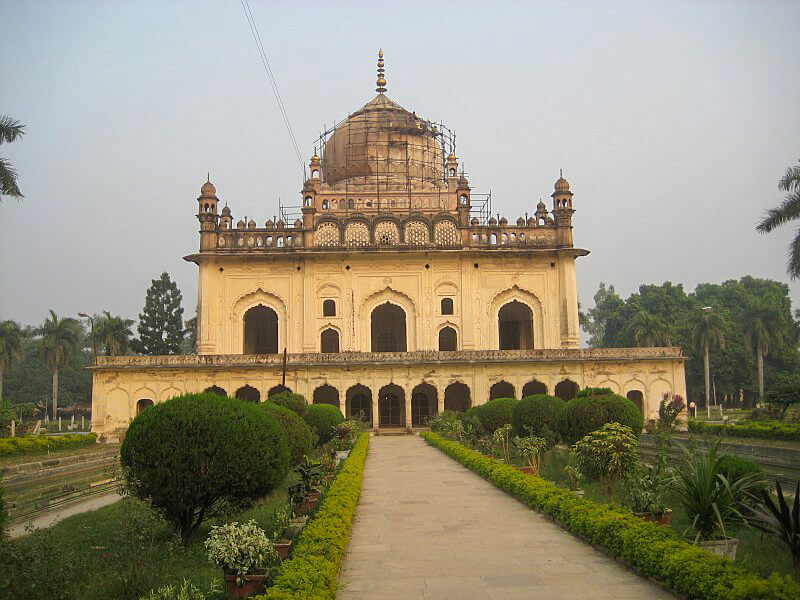
Although there are countless tombs in the country, the tomb of Bahu Begum is an excellent example of Mughal architecture. This tomb is made of white marble and has four towers around it. The main dome of the tomb is 24 meters high. Nawab Shuja-ud-Daula was the third Nawab of Awadh and this tomb was built by him in the late of 17th century in the memory of his wife Unmatuzohara, popularly known as Bahu Begum. He also constructed & renovated many other buildings in Ayodhya, including Hanumangarhi and Ram Janmabhoomi temple.
If you love to see architectural buildings & monuments. Then you must go there at once. You will definitely fascinated to see this adorable site.
Location
This tomb is located in the middle of the Ayodhya city & linked with other famous monuments.
How to Reach
This tomb is in the strategic location in Ayodhya City. So It will not be hard to find the exact location while traveling within the city. You can come here by Train, Roadways & Airways easily.
Conclusion
This ancient city Ayodhya is not only a home of spiritual places but also works as a bridge connecting the ancient with the contemporary. Adorable Villas, Stunning monuments, beautiful gardens, a rich library, an amazing look of the Saryu River front etc. give a pleasant look to Ayodhya city & make it a famous destination for pilgrimage along with architecture lovers & monuments explorers. Ultimately, It’s a priceless gem over the crown of entire India’s heritage culture. You must visit once in a life at least to see how beautiful India was in the past & present both.
Suggested Read:





Leave a reply